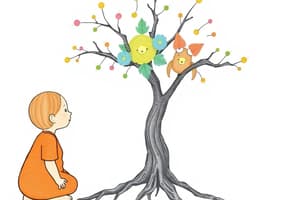Podcast
Questions and Answers
What did Piaget define as 'a cohesive, repeatable action sequence possessing component actions that are tightly interconnected and governed by a core meaning'?
What did Piaget define as 'a cohesive, repeatable action sequence possessing component actions that are tightly interconnected and governed by a core meaning'?
- Schema (correct)
- Cognitive conflict
- Equilibration
- Assimilation
When adolescents can deal with hypothetical problems with many possible solutions, according to Piaget, what cognitive stage have they reached?
When adolescents can deal with hypothetical problems with many possible solutions, according to Piaget, what cognitive stage have they reached?
- Sensorimotor stage
- Preoperational thought
- Concrete operational thought
- Formal operational thought (correct)
What sensation arises when individuals face a new situation that they cannot explain in terms of existing schemas?
What sensation arises when individuals face a new situation that they cannot explain in terms of existing schemas?
- Assimilation
- Cognitive conflict (correct)
- Accommodation
- Equilibration
What term is used to describe the process of changing mental models to better match the world?
What term is used to describe the process of changing mental models to better match the world?
According to Piaget, what is the motivation to learn triggered by?
According to Piaget, what is the motivation to learn triggered by?
According to Piaget, what is required to get back to a state of equilibrium when faced with contradictory views?
According to Piaget, what is required to get back to a state of equilibrium when faced with contradictory views?
In which stage of Erikson's psychosocial development would the conflict between industry and inferiority typically occur?
In which stage of Erikson's psychosocial development would the conflict between industry and inferiority typically occur?
Which stage is introspection replaced by paying attention to 'loss of capacities and disintegration' in Erikson's psychosocial development theory?
Which stage is introspection replaced by paying attention to 'loss of capacities and disintegration' in Erikson's psychosocial development theory?
What process involves using existing mental models to solve new experiences according to Piaget's theory?
What process involves using existing mental models to solve new experiences according to Piaget's theory?
'A way of organizing knowledge' is best described by which term in the context of cognitive development?
'A way of organizing knowledge' is best described by which term in the context of cognitive development?
In cognitive development, what refers to the child holding two contradictory views that cannot both be true?
In cognitive development, what refers to the child holding two contradictory views that cannot both be true?
According to Piaget's theory, what is the process of changing existing schemas to solve new experiences?
According to Piaget's theory, what is the process of changing existing schemas to solve new experiences?
At what age range do children begin to think logically about concrete events according to Piaget's theory of cognitive development?
At what age range do children begin to think logically about concrete events according to Piaget's theory of cognitive development?
Which stage of Piaget's theory is characterized by toddlers and young children acquiring the ability to internally represent the world through language and mental imagery?
Which stage of Piaget's theory is characterized by toddlers and young children acquiring the ability to internally represent the world through language and mental imagery?
What is the major characteristic of the Sensorimotor Stage in Piaget's theory of cognitive development?
What is the major characteristic of the Sensorimotor Stage in Piaget's theory of cognitive development?
Which stage of Piaget's theory involves children being less egocentric and beginning to consider others' perspectives?
Which stage of Piaget's theory involves children being less egocentric and beginning to consider others' perspectives?
What does the ability to make one thing stand for something other than itself represent in Piaget's theory of cognitive development?
What does the ability to make one thing stand for something other than itself represent in Piaget's theory of cognitive development?
During which stage of Piaget's theory can children mentally reverse things?
During which stage of Piaget's theory can children mentally reverse things?
Flashcards are hidden until you start studying
Study Notes
Formal Operational Thought
- Characterized by being entirely freed from physical and perceptual constraints
- Ability to follow the form of an argument without needing specific examples
- Can deal with hypothetical problems with many possible solutions
Schemas
- Defined by Piaget as "a cohesive, repeatable action sequence possessing component actions that are tightly interconnected and governed by a core meaning"
- Basic building blocks of intelligent behavior, a way of organizing knowledge
- Can be thought of as "units" of knowledge, each relating to one aspect of the world, including objects, actions, and abstract concepts
Equilibration and Disequilibrium
- When existing schemas can explain what we perceive, we are in a state of equilibration
- When we encounter a new situation that we cannot explain, it creates disequilibrium, an unpleasant sensation that motivates us to learn
- Disequilibrium is resolved by modifying existing schemas to learn and adapt to the new situation
Adaptation and Schema Change
- Adaptation is the process of changing mental models of the world to match reality
- Brought about by assimilation (solving new experiences using existing schemata) and accommodation (changing existing schemata to solve new experiences)
- The child is seen as an active participant in their own development, rather than a passive recipient of biological or environmental influences
Jean Piaget's Stages of Cognitive Development
Sensorimotor Stage (birth – 2 years)
- Infant learns about the world through senses and actions
- Emergence of the general symbolic function, capacity to represent the world mentally
- Infant understands object permanence at around 8 months and will search for disappeared objects
Pre-operational Stage (2 years – 7 years)
- Toddler acquires ability to internally represent the world through language and mental imagery
- Ability to think about things symbolically, using one thing to stand for another
Concrete Operational Stage (7 years – 11 years)
- Child thinks logically about concrete events
- Ability to mentally reverse things, such as picturing a ball of plasticine returning to its original shape
- Decreased egocentricity, ability to think about how others might think and feel
Formal Operational Stage (age 12 years and over)
- Concrete operations are carried out on things, whereas formal operations are carried out on ideas
Studying That Suits You
Use AI to generate personalized quizzes and flashcards to suit your learning preferences.



